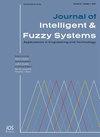Multi-objective shuffled frog leaping algorithm for deployment of sensors in target based wireless sensor networks
IF 1
4区 计算机科学
Q3 COMPUTER SCIENCE, ARTIFICIAL INTELLIGENCE
引用次数: 0
Abstract
In this research, –coverage –connected problem is viewed as multi-objective problem and shuffling frog leaps algorithm is proposed to address multi-objective optimization issues. The shuffled frog leaping set of rules is a metaheuristic algorithm that mimics the behavior of frogs. Shuffled frog leaping algorithms are widely used to seek global optimal solutions by executing the guided heuristic on the given solution space. The basis for the success of this SFL algorithm is the ability to exchange information among a group of individuals which phenomenally explores the search space. SFL improves the overall lifespan of the network, the cost of connection among the sensors, to enhance the equality of coverage among the sensors and targets, reduced sensor count for increased coverage, etc. When it comes to coverage connectivity issues, each target has to be covered using k sensors to avoid the loss of data and m sensors connected enhance the lifespan of the network. When the targets are covered by k sensors then the loss of data will be reduced to an extended manner. When the sensors are connected with m other sensors then the connectivity among the sensors will not go missing and hence the lifespan of the network will be improved significantly. Therefore, the sensor node number in coverage indicates the total number of sensor nodes utilised to cover a target, and the number of sensor nodes in connected reflects the total number of sensor nodes that provide redundancy for a single failed sensor node. Connectivity between sensor nodes is crucial to the network’s longevity. The entire network backbone acts strategically when all the sensors are connected with one or the other to pertain to the connectivity of the network. Coverage is yet another key issue regarding the loss of data. The proposed algorithm solves the connectivity of sensors and coverage of targets problems without weighted sum approach. The proposed algorithm is evaluated and tested under different scenarios to show the significance of the proposed algorithm.基于目标的无线传感器网络中传感器部署的多目标洗牌青蛙跳跃算法
本研究将覆盖连通问题视为多目标问题,提出了洗牌青蛙跳跃算法来解决多目标优化问题。洗牌蛙跳跃规则集是一种模拟蛙类行为的元启发式算法。洗牌青蛙跳跃算法通过在给定解空间上执行引导启发式来寻求全局最优解。这种SFL算法成功的基础是能够在一组个体之间交换信息,从而显著地探索搜索空间。SFL提高了网络的整体寿命,传感器之间的连接成本,以增强传感器和目标之间的覆盖公平性,减少传感器数量以增加覆盖范围等。当涉及到覆盖连接问题时,必须使用k个传感器覆盖每个目标以避免数据丢失,并且连接的m个传感器可以延长网络的使用寿命。当目标被k个传感器覆盖时,数据的丢失将以一种扩展的方式减少。当传感器与m个其他传感器连接时,传感器之间的连接将不会丢失,因此网络的寿命将显着提高。因此,覆盖中的传感器节点数表示用于覆盖目标的传感器节点总数,连接中的传感器节点数反映了为单个故障传感器节点提供冗余的传感器节点总数。传感器节点之间的连接对网络的寿命至关重要。当所有传感器都与其中一个或另一个连接时,整个网络骨干网的作用是战略性的,以保持网络的连通性。覆盖范围是关于数据丢失的另一个关键问题。该算法解决了传感器的连通性和目标的覆盖问题。在不同的场景下对所提出的算法进行了评估和测试,以表明所提出算法的重要性。
本文章由计算机程序翻译,如有差异,请以英文原文为准。
求助全文
约1分钟内获得全文
求助全文
来源期刊

Journal of Intelligent & Fuzzy Systems
工程技术-计算机:人工智能
CiteScore
3.40
自引率
10.00%
发文量
965
审稿时长
5.1 months
期刊介绍:
The purpose of the Journal of Intelligent & Fuzzy Systems: Applications in Engineering and Technology is to foster advancements of knowledge and help disseminate results concerning recent applications and case studies in the areas of fuzzy logic, intelligent systems, and web-based applications among working professionals and professionals in education and research, covering a broad cross-section of technical disciplines.
 求助内容:
求助内容: 应助结果提醒方式:
应助结果提醒方式:


